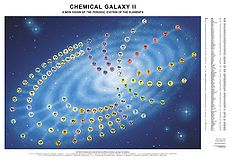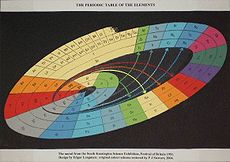
Chemical Galaxy
Encyclopedia



Philip Stewart
Philip Stewart, , is a British writer and academic.-History:He decided at an early age that he did not want to choose between arts and sciences. He took a first degree in 1961 at the University of Oxford, England in Arabic, then, as a young graduate IN 1962, translated a novel by Naguib Mahfouz...
of the periodic system of the elements, better known in tabular form as the periodic table
Periodic table
The periodic table of the chemical elements is a tabular display of the 118 known chemical elements organized by selected properties of their atomic structures. Elements are presented by increasing atomic number, the number of protons in an atom's atomic nucleus...
, based on the cyclical nature of characteristics of the chemical element
Chemical element
A chemical element is a pure chemical substance consisting of one type of atom distinguished by its atomic number, which is the number of protons in its nucleus. Familiar examples of elements include carbon, oxygen, aluminum, iron, copper, gold, mercury, and lead.As of November 2011, 118 elements...
s (which depend principally on the valence electron
Valence electron
In chemistry, valence electrons are the electrons of an atom that can participate in the formation of chemical bonds with other atoms. Valence electrons are the "own" electrons, present in the free neutral atom, that combine with valence electrons of other atoms to form chemical bonds. In a single...
s). Even before Dmitri Mendeleev
Dmitri Mendeleev
Dmitri Ivanovich Mendeleev , was a Russian chemist and inventor. He is credited as being the creator of the first version of the periodic table of elements...
produced the first satisfactory table, chemists were making spiral representations of the periodic system, and this has continued ever since, but these were usually circular in outline.
John D. Clark
John D. Clark
John Drury Clark, Ph.D. was a noted American rocket fuel developer, chemist, and science fiction writer and fan. He was instrumental in the revival of interest in Robert E. Howard's Conan stories and influenced the writing careers of L. Sprague de Camp, Fletcher Pratt, and other authors.- Life and...
was the first to present a spiral with an oval outline. His design was used as a vividly coloured two-page illustration in Life magazine for 16 May 1949. In 1951, Edgar Longman, an artist, not a chemist, painted a large mural, adapting the Life image by making the shape elliptical and tilting it to produce a dynamic effect. This inspired Stewart, then 12 years old, with a love of chemistry. Having just read Fred Hoyle
Fred Hoyle
Sir Fred Hoyle FRS was an English astronomer and mathematician noted primarily for his contribution to the theory of stellar nucleosynthesis and his often controversial stance on other cosmological and scientific matters—in particular his rejection of the "Big Bang" theory, a term originally...
's book The Nature of the Universe, he had the idea that Longman's design resembled a spiral galaxy
Spiral galaxy
A spiral galaxy is a certain kind of galaxy originally described by Edwin Hubble in his 1936 work The Realm of the Nebulae and, as such, forms part of the Hubble sequence. Spiral galaxies consist of a flat, rotating disk containing stars, gas and dust, and a central concentration of stars known as...
. He returned to the idea many years later and published a first version of his "galaxy" in November 2004. His design seeks to express the link between the utterly minute world of atoms and the vastness of the stars, in the interior of which the elements were forged, as Hoyle was the first to demonstrate in detail.
Chemical Galaxy is intended primarily to excite an interest in chemistry among non-chemists, especially young people, but it is fully accurate scientifically in the information that it conveys about relationships between the elements, and it has the advantage over a table that it does not break up the continuous sequence of elements. A revised version, Chemical Galaxy II, introduces a new scheme, inspired by Michael Laing
Michael Laing
Michael Laing taught chemistry at the University of Natal, Durban from 1964 until he retired as Professor of Inorganic Chemistry in 1997. He graduated from the University of California, Los Angeles in the field of x-ray crystallography, specializing in the determination of molecular structure...
, for coloring the lanthanide
Lanthanide
The lanthanide or lanthanoid series comprises the fifteen metallic chemical elements with atomic numbers 57 through 71, from lanthanum through lutetium...
s and actinide
Actinide
The actinide or actinoid series encompasses the 15 metallic chemical elements with atomic numbers from 89 to 103, actinium through lawrencium.The actinide series derives its name from the group 3 element actinium...
s, to bring out parallels with the transition metal
Transition metal
The term transition metal has two possible meanings:*The IUPAC definition states that a transition metal is "an element whose atom has an incomplete d sub-shell, or which can give rise to cations with an incomplete d sub-shell." Group 12 elements are not transition metals in this definition.*Some...
s. The design was translated into digital form by Carl Wenczek of Born Digital Ltd.

